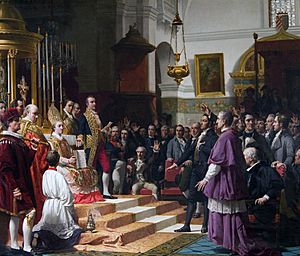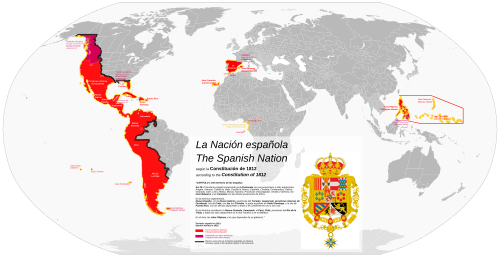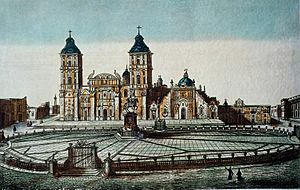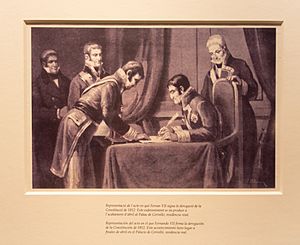Spanish Constitution of 1812 facts for kids
Quick facts for kids Constitution of Cádiz |
|
|---|---|
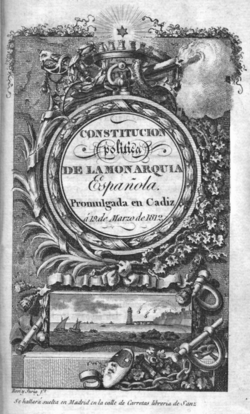
Original version of the Constitution kept in the Senate of Spain
|
|
| Cortes of Cádiz | |
| Political Constitution of the Spanish Monarchy | |
| Territorial extent | |
| Date passed | 19 March 1812 |
| Date enacted | 12 March 1812 |
| Signed by | President of the Cortes of Cádiz 174 deputies 4 secretaries |
| Date effective | 19 March 1812 (first time) 1 January 1820 (second time, de facto) 1836 (third time, de facto) |
| Date repealed | 4 May 1814 (first time) April 1823 (second time) 18 June 1837 (third time) |
The Constitution of Cádiz (also known as La Pepa) was Spain's very first constitution. It was one of the first written constitutions in the world. People officially approved it on March 19, 1812.
This important document was created by the Cortes of Cádiz. This was Spain's first national parliament. It included representatives from all over the Spanish Empire, even from places like Spanish America and the Philippines. The Constitution of Cádiz was a big step for freedom and new ideas in Spain and its colonies.
It was very modern for its time. It said that the people, not just the king, had the power. It also separated government powers into different groups. It allowed freedom of the press and supported free business. It created a constitutional monarchy, where the king's power was limited by laws. It even allowed most men to vote, which was very unusual back then.
However, when King Ferdinand VII returned to power in 1814, he got rid of the Constitution. He wanted to be an absolute monarch again. But the Constitution came back two more times. It was a very important example for future constitutions in Spain and other Spanish-speaking countries.
Contents
How Napoleon Changed Spain's Politics
Before 1808, King Ferdinand VII ruled Spain as an absolute monarch. This meant he had all the power. But then, Napoleon invaded Spain. He forced Ferdinand and his father, Charles IV, to give up their thrones. Napoleon then put his own brother, Joseph Bonaparte, in charge of Spain.
Napoleon tried to make his brother's rule seem legal. He gathered a group of Spanish leaders, called the Cortes. They approved a new constitution, the Bayonne Constitution. This constitution was based on French ideas. It also said that Spanish colonies in America and the Philippines would have some representatives.
But most people in Spain and its colonies did not accept Joseph Bonaparte as their king. They saw his rule as illegal. Napoleon's actions caused a huge crisis. It led to the collapse of the Spanish Empire. It also made people in the colonies demand more freedom and representation.
The Spanish Cortes of Cádiz
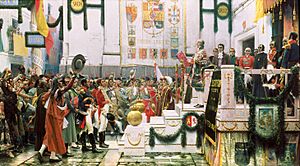
As the Spanish people dealt with Napoleon's invasion, they faced a big question: who was the real ruler? Many towns in Spain created their own local governments, called juntas. They did this to rule in the king's absence. A main group, the Supreme Central Junta, was formed to lead these local groups.
The Spanish leaders wanted to show that they were the true government. They called for a new Cortes (parliament). This Cortes would have representatives from all Spanish provinces. This included those in America and the Philippines. The Cortes met in Cádiz, a fortified port city. It was the safest place from the French army.
The Cortes of Cádiz worked on the Constitution while French troops surrounded the city. They met on an island called Isla de León, which was easy to defend. The leaders wanted to create a new system for Spain. Some wanted to go back to the old ways, with an absolute king. Others wanted a written constitution.
The Cortes did not plan a revolution at first. They saw themselves as continuing the legal government. But by resisting the French, they were already changing things. If the king was the only source of power, then Napoleon's actions would have made Joseph Bonaparte the true king. But the Spanish people rejected this idea.
The representatives in Cádiz were more open to new ideas than many other Spanish leaders. They created a document that was very liberal. Most of the conservative leaders were not in Cádiz. Also, King Ferdinand was a prisoner in France and could not influence them.
The liberal members of the Cortes were the majority. They had the support of the British, who were helping to protect Cádiz. These liberals wanted everyone to be equal under the law. They wanted a strong central government and a fair tax system. They also wanted to end old feudal privileges. They believed property owners should be free to use their land as they wished.
The Cortes quickly agreed on three main ideas:
- Power belongs to the nation, not just the king.
- Ferdinand VII was the rightful king.
- The representatives in the Cortes were protected from harm.
These ideas were the first steps towards a political revolution. Before Napoleon, Spain was ruled by absolute monarchs. The new Constitution greatly reduced the power of the king. It also limited the power of the Catholic Church, even though Catholicism remained the official religion.
Key Ideas of the Constitution
The main goal of the new Constitution was to stop unfair and corrupt royal rule. It created a limited monarchy. This meant the king ruled through ministers. These ministers had to answer to the parliament. The Constitution also set up the three parts of government: the executive (king and ministers), the legislative (Cortes), and the judicial (courts).
The Constitution had 384 articles, divided into 10 main chapters.
- Chapter I: About the Spanish Nation and its people.
- Chapter II: About Spanish territory, religion, government, and citizenship rights.
- Chapter III: About the Cortes, which was the law-making part of the government.
- Chapter IV: About the King's powers and limits.
- Chapter V: About the courts and how laws would be handled.
- Chapter VI: About local government in provinces and towns.
- Chapter VII: About taxes and money.
- Chapter VIII: About the national military.
- Chapter IX: About public education. It called for schools from primary to university. It also supported freedom of expression.
- Chapter X: About how to follow and change the Constitution.
Unlike some other constitutions, it did not have a separate "bill of rights." Instead, the rights and duties of citizens were included in different articles.
The Constitution allowed most men to vote, regardless of how much property they owned. This helped the business class gain more power in parliament. It also ended old rules about property, which helped create a freer economy. There was no rule about voters needing to read until 1830. This meant many ordinary men could vote.
The Constitution also created a single system for the entire empire. This included Spain and its overseas territories. It set up new, uniform provincial governments and towns. This replaced the many different local government structures that existed before.
Spanish Citizenship for All
One of the biggest debates while writing the Constitution was about the status of people in Spain's colonies. This included native people and those of mixed race. Most overseas provinces had representatives in Cádiz. This included places like Mexico, Peru, Central America, and the Philippines.
Out of 303 representatives, 37 were born in overseas territories. Many of these were temporary representatives chosen by Americans living in Cádiz. Most of the overseas representatives were Criollos (people of Spanish descent born in the Americas). They wanted all native, mixed-race, and free black people in the empire to have the right to vote. This would have given the overseas territories more power in the Cortes.
However, most representatives from Spain itself did not agree. They wanted to limit the power of non-Spanish-born people. Spain had about 10-11 million people. The overseas provinces had about 15-16 million.
The Constitution gave Spanish citizenship to all natives of Spanish territories. This included Indigenous peoples of the Americas. But it was harder for people of African descent to become citizens. They had to go through a special process. Slaves were not included.
Spanish citizens were defined as anyone born, naturalized, or living in Spanish territories for over ten years. Article 1 said: "The Spanish nation is the collectivity of the Spaniards of both hemispheres." This meant that people in the colonies, including indigenous people, became citizens. They were no longer just subjects of a king.
However, the Constitution did not automatically give citizenship to free black people or mulatos (people of mixed European and African descent). They also were not counted when deciding how many representatives a province could send to the Cortes. This removed about six million people from the voting count in the overseas territories. This was partly a way for Spanish representatives to keep more power. It also helped conservative Criollo leaders keep power within a small group.
Many Spanish representatives also did not like the idea of federalism. This would have given more self-rule to the American and Asian territories. Most Spanish leaders wanted a strong, central government. Another change was that taxes from overseas colonies would now go to the state, not directly to the king. This reduced the king's personal wealth.
Local Governments (Ayuntamientos)
The 1812 Constitution had a big impact on the new countries forming in Spanish America. Many important leaders from these future republics were part of the Cortes in Cádiz.
One key rule (article 310) said that every town with over 1,000 people should have a local government, called an ayuntamiento. This rule changed these local groups. They went from being controlled by a few powerful people to being chosen through elections. The elections were indirect, which still favored the wealthy.
This change helped the business class. It also greatly benefited the Criollos in the Americas. They became very powerful in the ayuntamientos. For example, in Cuzco, Peru, local leaders were happy to join the ayuntamiento. They worked with other local groups to oppose Spanish-born officials. The Constitution also brought some local self-rule. Elected local and provincial groups might not always agree with the central government.
When the Constitution Was Announced
The Constitution was signed in March 1812. But it was not immediately announced everywhere in the empire. In Mexico, the Viceroy allowed it to be published on September 19, 1812. In Peru, it was published on October 1, 1812.
In Mexico, the Viceroy had to deal with a huge rebellion that had just started. He faced two big problems at once: a rebellion and a new government system. In Peru, the Viceroy managed to control the elections and the press, even though the Constitution said the press should be free.
Ending and Bringing Back the Constitution
When King Ferdinand VII returned to power in March 1814, he first said he would support the Constitution. But in many towns, crowds welcomed him as an absolute monarch. They even destroyed signs that had renamed their town squares "Plaza of the Constitution."
Sixty-nine members of the Cortes signed a document asking him to bring back absolute rule. Within weeks, Ferdinand abolished the Constitution on May 4. He arrested many liberal leaders on May 10. He said the Constitution was illegal because it was made without him. He wanted to rule with all the power, just like before.
Ferdinand's absolute rule rewarded the old powerful groups: church leaders, nobles, and those who held office before 1808. But it did not reward the liberals. They wanted a king whose power was limited by a constitution. This made many people unhappy.
There were several attempts to bring back the Constitution. Finally, on January 1, 1820, some army officers started a rebellion. They demanded the Constitution be put back in place. The movement gained support across Spain. By March 7, the king had restored the Constitution.
Other European kings worried about the liberals' success. In 1822, they agreed to send French troops to Spain to support Ferdinand VII. After the French freed Ferdinand from the Cortes in August 1823, he again attacked the liberals.
After Ferdinand died in 1833, the Constitution was briefly in force again in 1836 and 1837. This was while a new constitution was being written. Since 1812, Spain has had seven constitutions. The one currently in use has been in place since 1978.
Lasting Impact
The Cortes of Cádiz created Spain's first written constitution. It was announced in Cádiz on March 19, 1812. This document is seen as the start of liberal ideas in Spain. It is one of the first examples of classical liberalism in the world. People called it the "sacred code" for a type of liberalism that did not fully support the French Revolution.
In the early 1800s, it was a model for liberal constitutions in many countries. This included nations around the Mediterranean Sea and in Latin America. It influenced the Norwegian Constitution of 1814. It also inspired the Portuguese Constitution of 1822 and the Mexican Constitution of 1824. It was even used in some Italian states during revolts in 1820 and 1821.
Images for kids
-
Constitution of 1812 monument in St. Augustine, Florida. This obelisk was erected when the city was the capital of the Spanish Florida.
-
Monument to the Constitution of 1812 in Cádiz, Spain
See also
 In Spanish: Constitución española de 1812 para niños
In Spanish: Constitución española de 1812 para niños
- American Provincial Deputation of Spain
- Bayonne Constitution
- Cádiz
- Cortes of Cádiz
- Dos de Mayo Uprising
- History of democracy in Mexico
- List of constitutions of Spain
- Napoleonic Code
- Retroversion of the sovereignty to the people
- San Fernando, Cádiz
- Spanish American wars of independence
- Trienio Liberal
Primary sources
- The Political Constitution of the Spanish Monarchy. Biblioteca Virtual "Miguel de Cervantes" on-line version of a partial translation originally published in Cobbett's Political Register, Vol. 16 (July–December 1814).


